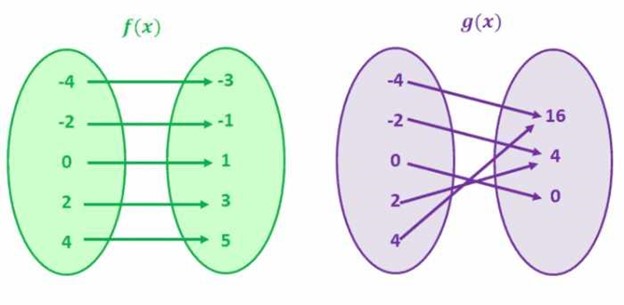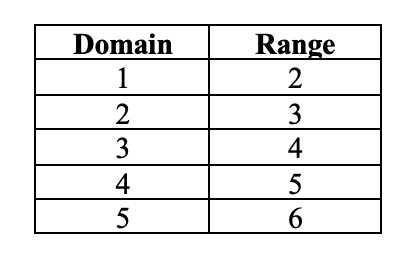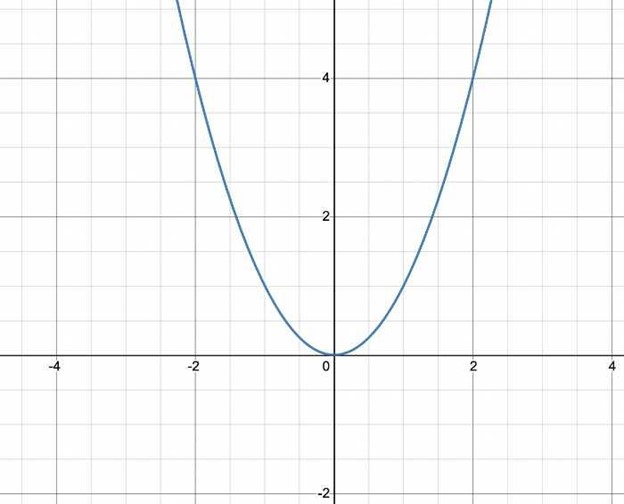One to One Functions - Graph, Examples | Horizontal Line Test
What is a One to One Function?
A one-to-one function is a mathematical function in which each input correlates to a single output. So, for each x, there is just one y and vice versa. This implies that the graph of a one-to-one function will never intersect.
The input value in a one-to-one function is the domain of the function, and the output value is noted as the range of the function.
Let's look at the pictures below:

For f(x), each value in the left circle correlates to a unique value in the right circle. In the same manner, each value on the right side correlates to a unique value on the left side. In mathematical terms, this implies every domain holds a unique range, and every range owns a unique domain. Hence, this is a representation of a one-to-one function.
Here are some different examples of one-to-one functions:
-
f(x) = x + 1
-
f(x) = 2x
Now let's study the second image, which displays the values for g(x).
Pay attention to the fact that the inputs in the left circle (domain) do not own unique outputs in the right circle (range). For instance, the inputs -2 and 2 have the same output, i.e., 4. In conjunction, the inputs -4 and 4 have equal output, i.e., 16. We can comprehend that there are matching Y values for multiple X values. Thus, this is not a one-to-one function.
Here are additional representations of non one-to-one functions:
-
f(x) = x^2
-
f(x)=(x+2)^2
What are the properties of One to One Functions?
One-to-one functions have these properties:
-
The function holds an inverse.
-
The graph of the function is a line that does not intersect itself.
-
The function passes the horizontal line test.
-
The graph of a function and its inverse are the same with respect to the line y = x.
How to Graph a One to One Function
To graph a one-to-one function, you will need to determine the domain and range for the function. Let's study a simple representation of a function f(x) = x + 1.

Once you have the domain and the range for the function, you ought to chart the domain values on the X-axis and range values on the Y-axis.
How can you determine whether a Function is One to One?
To indicate if a function is one-to-one, we can apply the horizontal line test. As soon as you graph the graph of a function, draw horizontal lines over the graph. In the event that a horizontal line moves through the graph of the function at more than one point, then the function is not one-to-one.
Because the graph of every linear function is a straight line, and a horizontal line will not intersect the graph at more than one point, we can also conclude all linear functions are one-to-one functions. Remember that we do not leverage the vertical line test for one-to-one functions.
Let's study the graph for f(x) = x + 1. Immediately after you chart the values of x-coordinates and y-coordinates, you ought to consider if a horizontal line intersects the graph at more than one point. In this example, the graph does not intersect any horizontal line more than once. This signifies that the function is a one-to-one function.

On the contrary, if the function is not a one-to-one function, it will intersect the same horizontal line more than one time. Let's look at the graph for the f(y) = y^2. Here are the domain and the range values for the function:

Here is the graph for the function:

In this example, the graph meets various horizontal lines. For instance, for each domains -1 and 1, the range is 1. In the same manner, for each -2 and 2, the range is 4. This implies that f(x) = x^2 is not a one-to-one function.
What is the inverse of a One-to-One Function?
As a one-to-one function has a single input value for each output value, the inverse of a one-to-one function also happens to be a one-to-one function. The inverse of the function basically reverses the function.
For example, in the case of f(x) = x + 1, we add 1 to each value of x for the purpose of getting the output, i.e., y. The inverse of this function will deduct 1 from each value of y.
The inverse of the function is denoted as f−1.
What are the properties of the inverse of a One to One Function?
The qualities of an inverse one-to-one function are the same as all other one-to-one functions. This implies that the inverse of a one-to-one function will have one domain for each range and pass the horizontal line test.
How do you determine the inverse of a One-to-One Function?
Determining the inverse of a function is simple. You simply have to swap the x and y values. For example, the inverse of the function f(x) = x + 5 is f-1(x) = x - 5.

Just like we reviewed previously, the inverse of a one-to-one function undoes the function. Because the original output value required adding 5 to each input value, the new output value will require us to deduct 5 from each input value.
One to One Function Practice Examples
Examine the subsequent functions:
-
f(x) = x + 1
-
f(x) = 2x
-
f(x) = x2
-
f(x) = 3x - 2
-
f(x) = |x|
-
g(x) = 2x + 1
-
h(x) = x/2 - 1
-
j(x) = √x
-
k(x) = (x + 2)/(x - 2)
-
l(x) = 3√x
-
m(x) = 5 - x
For every function:
1. Identify whether the function is one-to-one.
2. Plot the function and its inverse.
3. Figure out the inverse of the function mathematically.
4. State the domain and range of both the function and its inverse.
5. Use the inverse to determine the value for x in each equation.
Grade Potential Can Help You Master You Functions
If you are having problems trying to understand one-to-one functions or similar functions, Grade Potential can connect you with a one on one tutor who can assist you. Our Mesa math tutors are skilled educators who assist students just like you improve their skills of these subjects.
With Grade Potential, you can study at your own pace from the convenience of your own home. Schedule a call with Grade Potential today by calling (480) 428-3805 to find out more about our tutoring services. One of our consultants will call you to better inquire about your requirements to find the best instructor for you!




